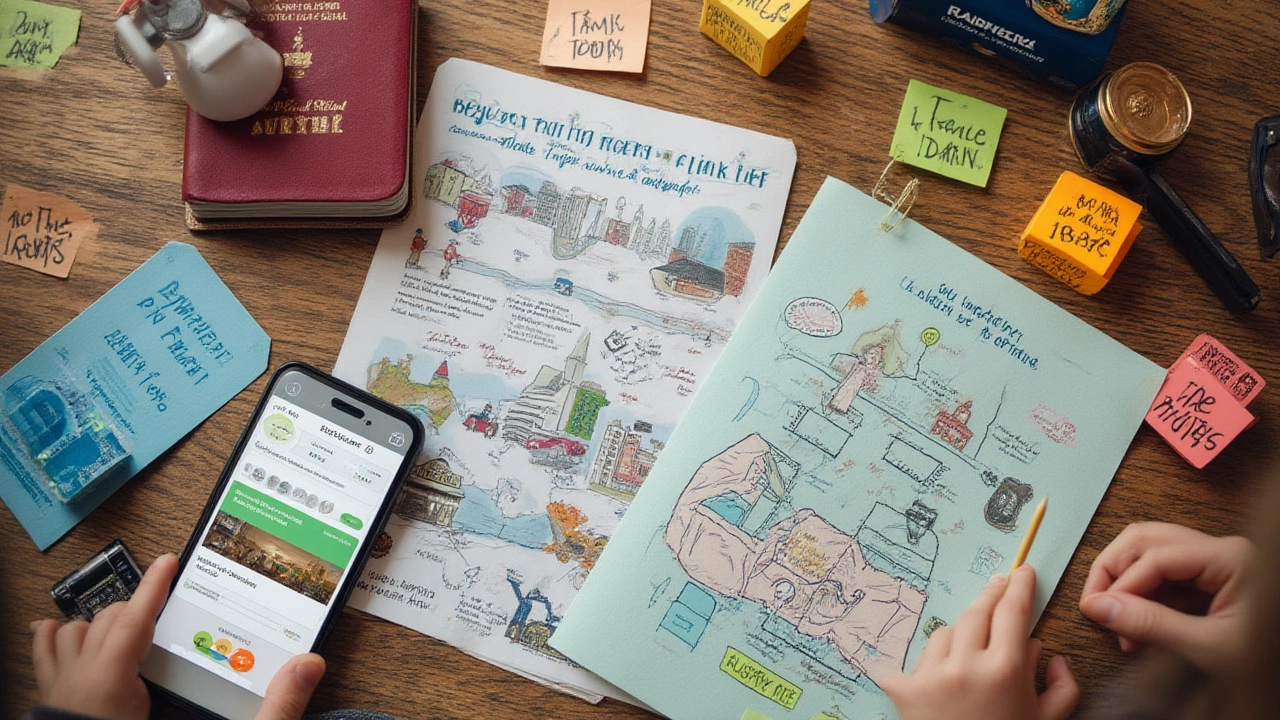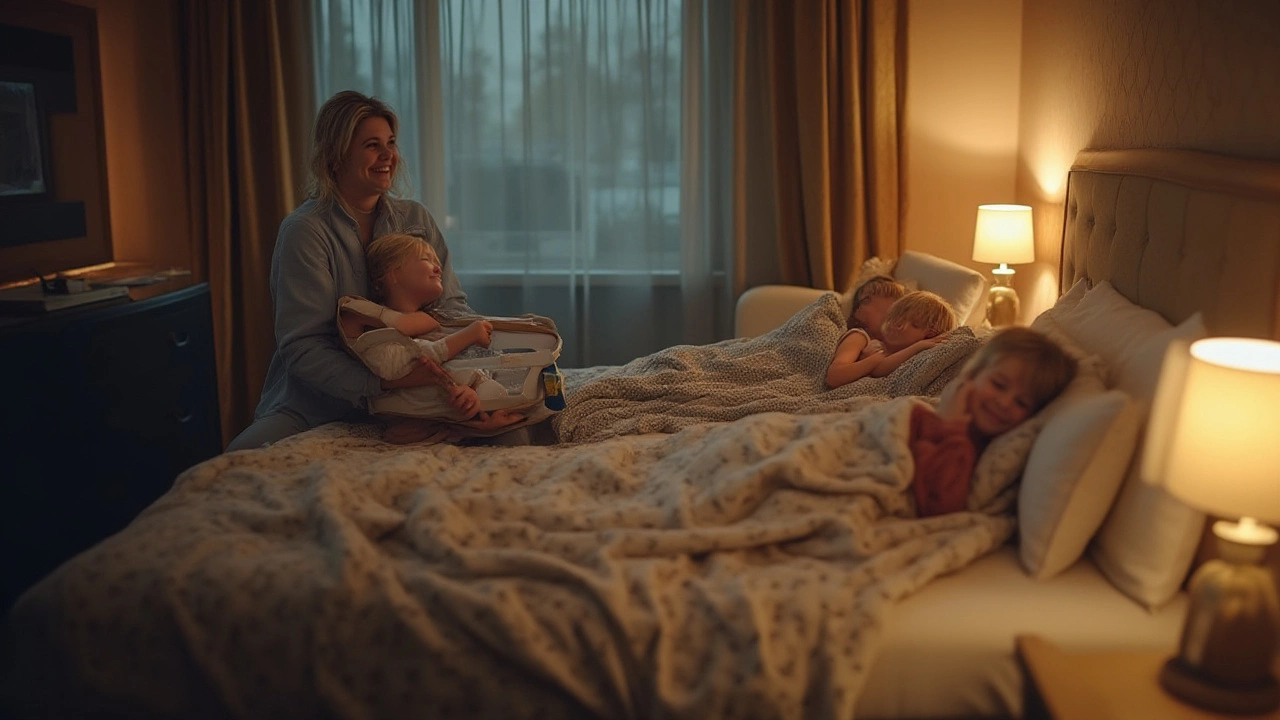Can a Family of 4 Stay in One Hotel Room? Tips & Realities Explained
7 Jul, 2025Ever tried squeezing four people and their mountain of travel bags into a single hotel room? You’re not the only one. The idea sounds simple enough—save money, keep the crew together, and avoid splitting everyone into different rooms. Hotels should make this a no-brainer, right? Not so fast. The answer is way more complicated than you’d expect. What you can get away with depends a lot on the hotel's rules, room sizes, booking fine print, and the age of your kids. Some places roll out the red carpet for traveling families. Others act like you’re smuggling in a circus troupe. Here’s what’s really going on.
The Unwritten Rules: What Hotels Really Allow
Most hotels throw around the term “standard occupancy” like everyone should know what it means. Usually, it’s two adults, but when you tack on a couple of kids, it suddenly gets messy. Some chains are super clear—kids under 12 stay free with parents using existing beds, like at Holiday Inn or some Marriott brands. Others play coy, forcing you to dig through fine print or call them up for a straight answer. If you show up with your whole crew and the front desk bats an eye, things can get awkward quickly.
The thing is, hotel safety codes (like fire safety laws) often set a strict maximum for each room. That max usually isn’t just some random number—it’s there because cramming extra people in a room can cause headaches in emergencies. Still, lots of places let two adults and two kids in a double room with two queen or double beds. But try stuffing four grown adults in, and you’ll probably get a hard no.
Some hotels don’t mind one or two kids bunking in with parents, but there are brands—especially older or boutique hotels—where even one extra kid is a dealbreaker due to room size. In major tourist cities (think Paris or London), rooms are famously tiny. That family of four might have to book two rooms—unless someone’s sleeping in the bathtub.
If you’re traveling abroad, the rules can flip completely. In Japan and parts of Europe, room rental is strictly “per person” rather than “per room.” That means extra fees for extra heads, sometimes even for babies. Always, always check the local policy before you pack the gang off on an adventure. In the US and Canada, though, most chain hotels are more relaxed about families sharing.
Navigating the Booking Maze
Online booking engines aren’t always your best friend here. You’d think marking “2 adults, 2 children” would give you all the family-friendly rooms, but sometimes the sites show just standard rooms that could be a squeeze. Some sites glitch and show a single king bed as “suitable”. Don’t take that at face value, or you might wake up sandwiched uncomfortably between everyone else on your trip.
The smart move? Filter your search by “family rooms” or “suites”—these options often have two beds plus a sleeper sofa or rollaway. But those come in short supply, and the price ticks up, especially during school breaks.
Cross-check what’s in the room. Is there a pullout couch? Will the hotel provide a free crib or rollaway? Sometimes rollaways cost extra, but for families with very young kids, a crib or cot might be free. Always call ahead and get them to email you confirmation. Otherwise, you might show up tired, kids cranky, and find you’re stuck splitting beds or floorspace with your luggage.
Some families get creative—traveling with an inflatable mattress, folding foam pad, or even sleeping bags. As long as you’re not blocking fire exits, most hotels will look the other way. Still, hotels vary: some are strict on fire code—no extras, no exceptions. Others shrug and let you figure it out.
If you find a great rate online, but aren’t quite sure about the setup, call the property, not the general 1-800 hotel chain line. The local front desk usually knows what’s possible and they’ll tell you if a rollaway fits, or if you’re better off with a suite. Hotels prefer families book directly—sometimes they’ll toss in breakfast or waive fees if you ask nicely.

The Pros and Cons of One Room for Four
Staying together comes with big wins. You only pay for a single room, which is always easier on the budget. You get to keep an eye on kids, and there’s no awkward dash between adjoining doors at midnight. Packing up and checking out becomes way simpler when everything (and everyone) is in one spot.
On the flip side, size matters, and even the most chill family can get cranky while sharing a shoebox-sized room. It’s not just about sleeping arrangements—it’s about storage, privacy (good luck with late-night shows, romance, or even bathroom time), and noise. Someone’s snoring. Someone’s watching cartoons (probably both you and the kids at that point). Someone’s leaping on the bed.
Let’s talk bathrooms. If you all have to be up early, a single bathroom can turn into gridlock. Forget getting out the door in half an hour. And the more people in a small space, the more likely someone’s going to trip over a suitcase or step on someone else’s leg in the dark.
If your kids are older—say, teenagers—expect even more arguments over space, screen time, and whose turn it is to shower. A few family fights are almost inevitable. That being said, some families actually love the togetherness. Late-night pillow talk, board games in bed, or sharing stories from the day can turn into genuine memories.
Then, there’s a safety angle. If you’re somewhere new or traveling internationally, it can be pretty reassuring having everyone close instead of across the hall. And with hotel doors sometimes tricky to lock, you’ll sleep better with all hands accounted for.
Tactics for Savvy Families
Ready to make one room work for four? First, ask about family hotel room options, even if the website doesn’t mention them. A lot of places have hidden gems or “junior suites” that aren’t well-advertised. Some chain hotels like Embassy Suites, Residence Inn, and Homewood Suites design their rooms with families in mind, boasting mini-kitchens, big sitting areas, and extra bedding for the kids.
Don’t forget about suite hotels or even aparthotels, which often come with two beds plus a pullout, or sectioned sitting rooms. Sometimes, booking a corner suite or a room on the executive floor isn’t much pricier than two basic rooms. And yeah, you’ll usually get a breakfast buffet tossed in.
Always pack a few snacks and water bottles to avoid pricey minibar charges or late-night drama when the kids get hungry. If the room is tight, keep luggage minimized—rolling duffel bags stash easier than boxy suitcases.
Pack a sound machine or app to drown out the noise (or snoring). Ear plugs and eye masks go a long way. If you want a little extra privacy, a simple curtain or blanket draped off a wall or bunk offers a “room within a room.”
For families with kids, some hotels can provide connecting rooms. These can be lifesavers—double the space, but doors in between for supervision. Sometimes, you can negotiate a deal directly with the hotel for an adjoining setup at a better price than two outright rooms.
If you’ve got a loyalty program with a hotel chain, always mention it. Loyalty members often get bumped up to bigger rooms or offered rollaway beds for free. Don’t be shy about asking; you paid those points, so get your perks.
European hotels sometimes still have “family pensions” (think old-school, no-frills guesthouses) or apartment-style units for rent. In places like Italy or Spain, families often stay together in tiny studios with a kitchenette and save money eating in.
Then, there’s Airbnb and vacation rentals. For some families, ditching hotels for a whole apartment or house is a no-brainer, giving everyone a real bedroom and a living space. Watch out for cleaning fees and “guest limits,” though—hosts can get strict if you go over their headcount.

Hotel Policies and Global Differences
Hotel policies vary, and that can catch even seasoned travelers off guard. In North America, there’s plenty of leeway for young children—sometimes even babies aren’t counted in official occupancy. The bigger hotel chains cater to families, so they anticipate kids camping out with parents. Chains like Hilton and Best Western spell out their kid policies right on the booking page.
But travel further afield, and you run into surprises. French city hotels, for example, often cap rooms at three guests. In Scandinavia or Japan, codes are so strict that you might need proof of your family’s ages at check-in. A trip to Sydney? Aussie hotels let families bunk together, but ask about extra bedding or cribs in advance—they charge per item.
Individual hotel managers sometimes have their own discretion, so a friendly call or email explaining your situation pays off. Honesty really is the best policy—getting caught sneaking in extra guests leads to awkward talks or even room eviction. A recent article from Lonely Planet put it best:
"Most hotels want to help families travel comfortably, but hiding guests can burn bridges. Always be upfront and check local occupancy laws.”
If you’re planning a long stay or traveling with infants, see if the hotel offers laundry, mini-fridge, or a microwave. Sometimes a “suite” is just a slightly bigger room—but other times, it means an actual apartment with doors and a kitchen. The price spread can be crazy, depending on the city and the time of year.
Some resorts offer “kids stay free” deals, or let kids eat for free at the hotel restaurant. Always look out for these promotions on the hotel’s website—sometimes they aren’t flagged on Expedia or Booking.com. That little tweak in your search could save a serious chunk of money, or mean the difference between a stressful stay and a smooth one.
Beyond hotels, consider youth hostels—more upscale than you’d think these days—many offer family bunk rooms with their own bathrooms for way less than a hotel suite. Plus, communal kitchens and lounges mean you can make snacks and unwind outside the cramped space of your room.
So, can a family of four stay in one hotel room? Most places, yes. But it’s never a guarantee. Do your homework, check for secret policies, and reach out before you show up. That bit of extra prep keeps your trip on track and everyone in your crew a little saner.

 by
by